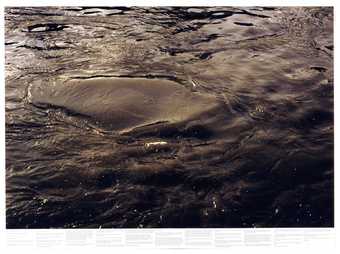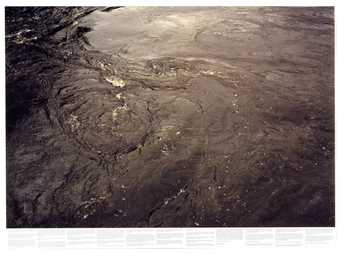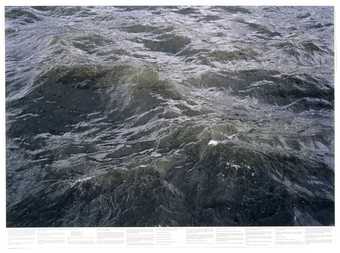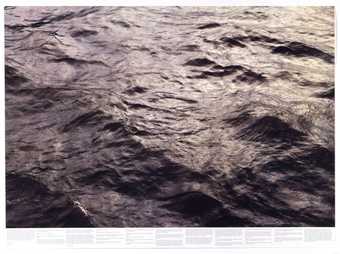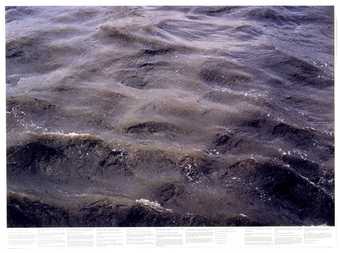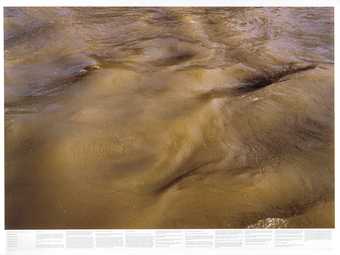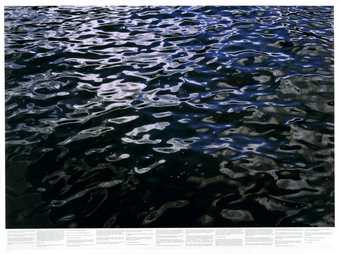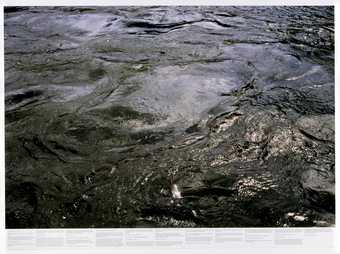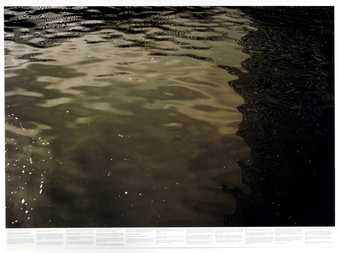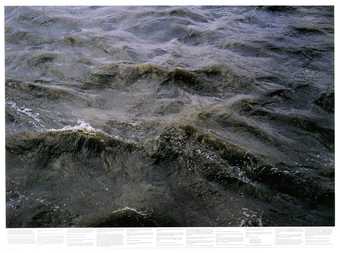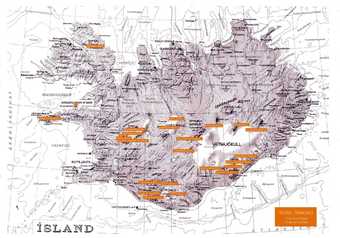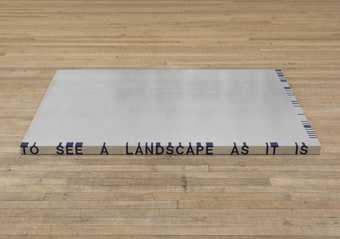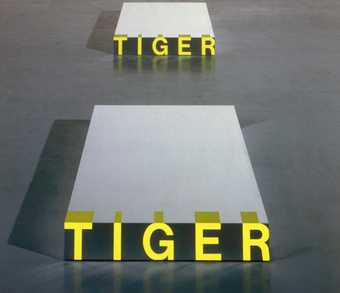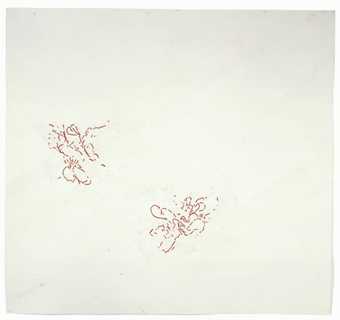Not on display
- Artist
- Roni Horn born 1955
- Medium
- Glass
- Dimensions
- Object: 1100 × 1200 × 1200 mm, 4514 kg
- Collection
- Tate
- Acquisition
- Purchased with funds provided by Tate Americas Foundation, the North American Acquisitions Committee, the Art Fund, Tate Members, Tate Patrons, the artist and with additional assistance from Dominque Levy in honor of Dorothy Berwin 2016
- Reference
- T14525
Summary
Pink Tons is a large cube-shaped sculpture made of solid cast glass. The base and four sides of the cube are composed of frosted pink glass and maintain scratches and irregularities generated by the casting mould, while the glass at the top of the sculpture is clear. When viewed from the side, the sculpture appears cloudy; when viewed from above, the work seems transparent, with the glass inside taking on a rippled or watery effect. The work is extremely heavy, weighing 4514 kilograms or 4.5 tons – a measurement referenced in the title Pink Tons. It is displayed on the gallery floor, although a thin mat of Perspex or silicon may be used as a support. The sculpture is intended to be placed at least 1.2 metres away from any of the gallery walls, and to be located near a window to achieve the correct lighting effect. The sheer weight of the object means it is difficult to place it in the centre of a room.
Pink Tons was made by the New York-based American artist Roni Horn. It was manufactured by the German glass company Schott, with whom Horn has collaborated since the 1970s. The original version of Pink Tons was made in 2009 and first shown that same year at Horn’s retrospective at Tate Modern, London, but the work was refabricated on the occasion of its acquisition by Tate.
Large cast glass objects, such as the pair of deep blue blocks Untitled (Flannery) 1997 (Solomon R. Guggenheim Museum, New York) and the solid red block Untitled (Aretha) 2002–4 (Museum of Modern Art, New York), have become a prominent feature of Horn’s work since the late 1990s. In a 2013 interview with the artist and curator Julie Ault, Horn said:
In the glass pieces, what fascinates me has a lot to do with the essence of something that has one appearance but is really something completely different. For example, glass is a (super-cooled) liquid, not a solid. It’s a pretty amazing thing that a material as ubiquitous as glass can masquerade like that. It’s like having a mask but the mask is identical to the real thing.
(Quoted in Fundació Joan Miró 2014, p.128.)
The cloudy sides and transparent top of Pink Tons seem to highlight notions of deception and mutability in a seemingly solid object, especially when light is reflected and refracted through the sculpture. In 2008 the art historian Mignon Nixon argued that this work confirms Horn’s attraction ‘to the mercurial life of “substances”’ (Nixon 2009, p.182).
With its emphasis on geometric form, Pink Tons can also be seen in relation to the history of minimalist sculpture, which first emerged in the late 1950s, and especially to works such as Untitled 1972 (Tate T06524), an open-topped copper box with a bright red inside base by the American artist Donald Judd, who was an early collector of Horn’s work. Given that minimalism has historically been dominated by male artists, Horn’s use in Pink Tons of pink frosted glass within such a large and heavy object may be seen as an attempt to question traditional conceptions of ‘masculine’ and ‘feminine’ art.
Born in New York in 1955, Horn trained at the Rhode Island School of Design (1972–5) and at Yale University (1976–8). Her work has been especially influenced by recurrent journeys to Iceland, a country she first visited in 1975, and especially its geology and landscape. You are the Weather 1994–5 (Museum De Pont, Tilburg) is a set of one hundred colour and black and white photographs that show the changing expressions of a young woman as she emerges from hot pools around Iceland, while Vatnasafn / Library of Water 2007 is a permanent installation in the Icelandic town of Sykkishólmur that comprises twenty-four glass columns each filled with glacier water taken from around the country. Horn’s practice has additionally involved a close engagement with poetry, literature and other texts. To Place is an ongoing book series that Horn began in 1990, while her series White Dickinson 2006–10 features thin sculptures propped against the gallery wall that display short quotations from the work of the American poet Emily Dickinson (1830–1886).
Further reading
Roni Horn aka Roni Horn, exhibition catalogue, Tate Modern, London 2009, reproduced pp.210–11.
Mignon Nixon, ‘Roni Horn’, Artforum, vol.48, no.1, September 2009, pp.282–3, reproduced p.282.
Roni Horn: Everything Was Sleeping as if the Universe Were a Mistake, exhibition catalogue, Fundació Joan Miró, Barcelona 2014.
Richard Martin
May 2016
Supported by Christie’s.
Does this text contain inaccurate information or language that you feel we should improve or change? We would like to hear from you.
Display caption
Horn is fascinated by ambiguity and processes of change. Pink Tons is an imposingly solid presence in the gallery. Yet its appearance is continually changing, as the natural light that passes through it varies in intensity at different times of day. The sides are rough-edged, having been in contact with the surface of the mould. By contrast their top surfaces are highly reflective since here the glass has only been in contact with air during the casting process.
Gallery label, October 2016
Does this text contain inaccurate information or language that you feel we should improve or change? We would like to hear from you.
You might like
-
Roni Horn [no title]
1999 -
Roni Horn [no title]
1999 -
Roni Horn [no title]
1999 -
Roni Horn [no title]
1999 -
Roni Horn [no title]
1999 -
Roni Horn [no title]
1999 -
Roni Horn [no title]
1999 -
Roni Horn [no title]
1999 -
Roni Horn [no title]
1999 -
Roni Horn [no title]
1999 -
Roni Horn [no title]
1999 -
Roni Horn Water, Selected
2007 -
Roni Horn Thicket No. 1
1989–90 -
Roni Horn Thicket No. 2
1990, reconstructed 1999 -
Roni Horn Were 12
2004


